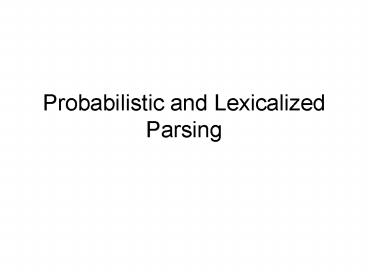Probabilistic and Lexicalized Parsing - PowerPoint PPT Presentation
1 / 31
Title:
Probabilistic and Lexicalized Parsing
Description:
Denver. NP. Cocke-Younger-Kasami Parser. Bottom-up ... John. Base Case: A. w NP. John. called. NP. Mary. V. from. NP. Denver. P. Recursive Cases: A. BC NP ... – PowerPoint PPT presentation
Number of Views:57
Avg rating:3.0/5.0
Title: Probabilistic and Lexicalized Parsing
1
Probabilistic and Lexicalized Parsing
2
Probabilistic CFGs
- Weighted CFGs
- Attach weights to rules of CFG
- Compute weights of derivations
- Use weights to pick, preferred parses
- Utility Pruning and ordering the search space,
disambiguate, Language Model for ASR. - Parsing with weighted grammars (like Weighted FA)
- T arg maxT W(T,S)
- Probabilistic CFGs are one form of weighted CFGs.
3
Probability Model
- Rule Probability
- Attach probabilities to grammar rules
- Expansions for a given non-terminal sum to 1
- R1 VP ? V .55
- R2 VP ? V NP .40
- R3 VP ? V NP NP .05
- Estimate the probabilities from annotated corpora
P(R1)counts(R1)/counts(VP) - Derivation Probability
- Derivation T R1Rn
- Probability of a derivation
- Most likely probable parse
- Probability of a sentence
- Sum over all possible derivations for the
sentence - Note the independence assumption Parse
probability does not change based on where the
rule is expanded.
4
Structural ambiguity
- S ? NP VP
- VP ? V NP
- NP ? NP PP
- VP ? VP PP
- PP ? P NP
- NP ? John Mary Denver
- V -gt called
- P -gt from
John called Mary from Denver
S
VP
NP
NP
V
NP
PP
called
John
Mary
P
NP
from
Denver
5
Cocke-Younger-Kasami Parser
- Bottom-up parser with top-down filtering
- Start State(s) (A, i, i1) for each A?wi1
- End State (S, 0,n) n is the input size
- Next State Rules
- (B, i, k) (C, k, j) ? (A, i, j) if A?BC
6
Example
7
Base Case A?w
8
Recursive Cases A?BC
9
(No Transcript)
10
(No Transcript)
11
(No Transcript)
12
(No Transcript)
13
(No Transcript)
14
(No Transcript)
15
(No Transcript)
16
(No Transcript)
17
(No Transcript)
18
(No Transcript)
19
(No Transcript)
20
(No Transcript)
21
Probabilistic CKY
- Assign probabilities to constituents as they are
completed and placed in the table - Computing the probability
- Since we are interested in the max P(S,0,n)
- Use the max probability for each constituent
- Maintain back-pointers to recover the parse.
22
Problems with PCFGs
- The probability model were using is just based
on the rules in the derivation. - Lexical insensitivity
- Doesnt use the words in any real way
- Structural disambiguation is lexically driven
- PP attachment often depends on the verb, its
object, and the preposition - I ate pickles with a fork.
- I ate pickles with relish.
- Context insensitivity of the derivation
- Doesnt take into account where in the derivation
a rule is used - Pronouns more often subjects than objects
- She hates Mary.
- Mary hates her.
- Solution Lexicalization
- Add lexical information to each rule
23
An example of lexical information Heads
- Make use of notion of the head of a phrase
- Head of an NP is a noun
- Head of a VP is the main verb
- Head of a PP is its preposition
- Each LHS of a rule in the PCFG has a lexical item
- Each RHS non-terminal has a lexical item.
- One of the lexical items is shared with the LHS.
- If R is the number of binary branching rules in
CFG, in lexicalized CFG O(2?R) - Unary rules O(?R)
24
Example (correct parse)
Attribute grammar
25
Example (less preferred)
26
Computing Lexicalized Rule Probabilities
- We started with rule probabilities
- VP ? V NP PP P(ruleVP)
- E.g., count of this rule divided by the number of
VPs in a treebank - Now we want lexicalized probabilities
- VP(dumped) ? V(dumped) NP(sacks)PP(in)
- P(ruleVP dumped is the verb sacks is the
head of the NP in is the head of the PP) - Not likely to have significant counts in any
treebank - Back-off to lesser contexts until reliable
estimates
27
Another Example
- Consider the VPs
- Ate spaghetti with gusto
- Ate spaghetti with marinara
- Dependency is not between mother-child.
Vp (ate)
Vp(ate)
Np(spag)
Vp(ate)
Pp(with)
Pp(with)
np
v
v
np
Ate spaghetti with marinara
Ate spaghetti with gusto
28
Log-linear models for Parsing
- Why restrict to the conditioning to the elements
of a rule? - Use even larger context
- Word sequence, word types, sub-tree context etc.
- In general, compute P(yx) where fi(x,y) test
the properties of the context li is the weight
of that feature. - Use these as scores in the CKY algorithm to find
the best scoring parse.
29
Parsing as sequential decision making process
- Parsing A series of decisions
- Lexical category label, structural attachment,
phrasal category label - Each decision is trained using some context as a
classification task - Classification techniques (SVM, MaxEnt, Decision
Trees) can be used to train these decision
classifiers. - Context could depend on previous decisions
(CKY-style decoding) - CFGs can be recognized using Push Down Automata
(PDA) - Probabilistic extensions of PDA
30
Supertagging Almost parsing
Poachers now control the
underground trade
S
S
VP
NP
S
NP
NP
V
VP
NP
e
N
NP
V
e
poachers
e
Adj
underground
- Selecting the correct supertag for a word is
almost parsing - Use classifiers to select the correct supertag
31
Summary
- Parsing context-free grammars
- Top-down and Bottom-up parsers
- Mixed approaches (CKY, Earley parsers)
- Preferences over parses using probabilities
- Parsing with PCFG and PCKY algorithms
- Enriching the probability model
- Lexicalization
- Log-linear models for parsing
- Classification techniques for parsing decisions































